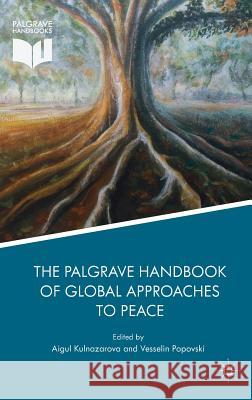The Palgrave Handbook of Global Approaches to Peace » książka



The Palgrave Handbook of Global Approaches to Peace
ISBN-13: 9783319789040 / Angielski / Twarda / 2019 / 765 str.
The Palgrave Handbook of Global Approaches to Peace
ISBN-13: 9783319789040 / Angielski / Twarda / 2019 / 765 str.
(netto: 956,21 VAT: 5%)
Najniższa cena z 30 dni: 963,86
ok. 22 dni roboczych.
Darmowa dostawa!
This volume examines conceptual, disciplinary, institutional (normative) and global interpretive frameworks for making and building peace in the context of roles played by state and non-state actors within local, national, regional, and global units of analysis.
PART I
INTRODUCTION
1 Framework for Global Approaches to Peace: An Introduction
Aigul Kulnazarova (Tama University, Japan)PART II
CONCEPTUAL APPROACHES TO PEACE
Introduction: Ideas and Individuals
2 Cosmopolitan Paths to Peace
Richard Falk (Princeton University, USA)
3 Peace, R2P and Public Goods Theory
Bjørn Møller (Aalborg University, Denmark)
4 Gandhism and Peace
Ramin Jahanbegloo (Jindal Global University, India)
5 Feminist Continua in Peace and Conflict Studies
Amanda E. Donahoe (Centenary College of Louisiana, USA)6 The Liberal Peace: Challenges to Development, Democracy and Soft Power
Syed Mansoob Murshed (Erasmus University, The Netherlands)
7 Human Security and the Socialization of Peace
Leonard Hammer (The University of Arizona, USA)
PART III
DOMESTIC APPROACHES TO PEACE
Introduction: States and Societies
8 Singapore’s Small State Domestic Peacemaking: “Quiet under the Banyan Tree”
Alan Chong (Nanyang Technological University, Singapore)
9 Peace in Rwanda: Balancing the ICTR and “Gacaca” in Postgenocide Peacebuilding
Jean-Damascène Gasanabo (The National Commission for the Fight against Genocide, Rwanda)
10 Operationalizing Positive Peace: Canadian Approaches to International Security Policy and Practice
D. Conor Seyle (One Earth Foundation Research, Canada)11 Russian Approaches to International Peace, Security and Institutions: Debating Within IR Schools
Alexander Sergunin (Saint Petersburg University, Russia)
12 Reframing the Principle of Noninterference: Reflections of Chinese School Debates and Beijing’s Approach to Peace
Li Li (Shanghai University of International Business and Economics, China)
13 Japan’s Thorny Path to Peace: Past, Present and Future
Kazuya Asakawa (Tokaigakuen University, Japan)14 Building Peace Through Ubuntu in the Aftermath of Electoral Violence in Divided African Societies
Lembe Tiky (University of Connecticut, USA)
15 Did Colombians Really Say “No” to Peace?: A Grassroots Peace Activism Versus Top-down Approach
Juan Fernando Lucio (Pasa Colombia, Colombia)
D. Conor Seyle (One Earth Foundation Research, Canada)
Alexandra Amling (Pasa Colombia, Colombia)
PART IV
REGIONAL APPROACHES TO PEACE
Introduction: Regions and Institutions
16 Peace in Europe: The Role of the European Union in Peacebuilding and Security
Maria Stoicheva (University of Sofia, Bulgaria)
17 Which “ASEAN Way” Forward?: Southeast Asian Perspectives on Peace and Institutions
Ekaterina Koldunova (Moscow State Institute of International Relations, Russia)
18 A Latin American Approach to Peace: The Case of MERCOSUR
Felicitas Acosta (Universidad Nacional de La Plata, Argentina) 19 The African Peace and Security Architecture: An African Response to Regional Peace and Security ChallengesDêlidji Eric Degila (Graduate Institute Geneva, Switzerland)
Charles K. Amegan (Independent Consultancy, France)
20 Official Discourses on Peace and Security in Post-Soviet Central Asia Medet Tiulegenov (The American University of Central Asia, The Kyrgyz Republic)
PART V
SYSTEMIC APPROACHES TO PEACE
Introduction: Institutions and Processes
21 International Women’s Organizations, Peace and Peacebuilding
Joyce Goodman (The University of Winchester, UK)
22 The Role of Religious Institutions: Peace in Eastern Orthodoxy
Yuri Stoyanov (The University of London, UK)
23 The OECD Development Assistance Committee and Peace: Instituting Peace by Economic Means
Christian Ydesen (Aalborg University, Denmark)
Joren Verschaeve (Ghent University, Belgium)24 The UN Security Council and Responsibility to Protect as Global Approach to Prevent Mass Atrocities
Vesselin Popovski (Jindal Global University, India)
25 Peace Process, International Organizations and the “Kurdish Question”
Pavel Shlykov (Moscow State University, Russia)26 The Role of International Organizations in Peace and Reconciliation in Kenya
Johannes Dragsbaek Schmidt (Aalborg University, Denmark)
Michael Omondi Owiso (Maseno University, Kenya)
27 Transnational Governance and Peace Processes: The Case of the UN and ICC in Colombia
Adriana Rincón (The University of Massachusetts Boston, USA)Consuelo Sánchez Bautista (Consultancy, Peace Education, Colombia and Ecuador)
Jeffrey D. Pugh (The University of Massachusetts Boston, USA)
PART VI
ALTERNATIVE APPROACHES TO PEACE
Introduction: What’s next?
28 Peace Institutions: Gandhism, Conflict Solution, Lifting the Bottom Up
Johan Galtung (Transcend International, Norway)29 Toward Engendered-Sustainable Peace to End Patriarchal Violence
Úrsula Oswald Spring (National University of Mexico, Mexico)
30 Transitional Justice: Between Peacebuilding and Reconciliation
Anja Mihr (Center on Governance through Human Rights, Germany)
31 Peace, Politics and Religion
Jeffrey Haynes (London Metropolitan University, UK)32 Approaching Peace Visually: Global Imaginaries and Narratives of Everyday Peacebuilding
Tommaso Durante (Royal Melbourne Institute of Technology, Australia)
33 In Search for Peace in the Arctic
Valery Konyshev (Saint Petersburg State University, Russia)
Alexander Sergunin (Saint Petersburg State University, Russia)
34 International Norms and Future Peacebuilding
Alistair D. Edgar (Wilfred University, Canada)
PART VII
CONCLUSION
35 The Global Approaches and the Future of Peace Research
Vesselin Popovski (Jindal Global University, India)
1997-2026 DolnySlask.com Agencja Internetowa
KrainaKsiazek.PL - Księgarnia Internetowa









